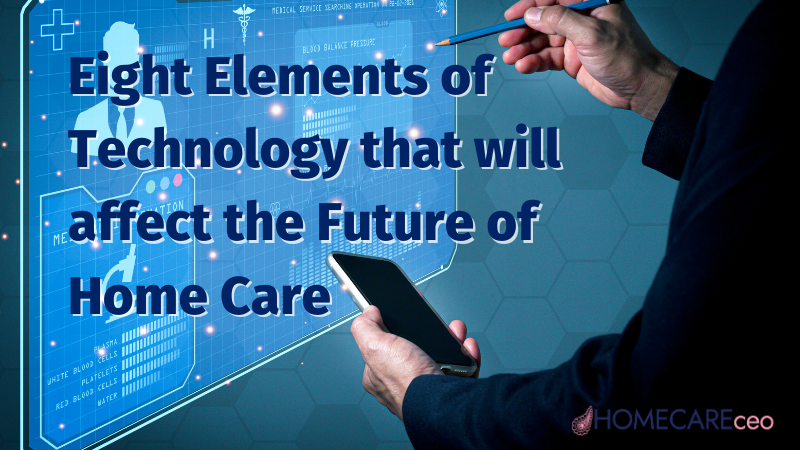By Stephen Tweed
What will the future of home care look like five years from now?
What role will technology play in that future and what are the elements of technology that will have the biggest impact?
We are in the middle of a project to explore the future of Home Care, and one area that will make a
huge impact in technology. We all know that technology is a big part of the future of home care, and we
also know that Home Care lags behind other sectors of health care in the application of technology.
As we look at the future of technology in Home Care, we have identified eight elements that we think
will affect the future. What do you think?
Eight Elements of Technology
Here are the eight elements that we have been studying. Which ones will have the biggest impact?
Artificial Intelligence (AI): Personalized Care Intelligence
AI is at the forefront of transforming home care by analyzing vast datasets and tailoring care plans based
on individual health profiles. With AI, caregivers can leverage predictive analytics to anticipate health
needs, ensuring timely interventions and preventing complications. The integration of AI is paving the
way for more efficient and individualized healthcare solutions, enhancing the overall quality of care
provided in home settings.
Remote Patient Monitoring: Real-Time Insights at Home
The advent of remote patient monitoring technologies empowers patients to actively engage in their
healthcare journey. Wearable devices and monitoring tools provide real-time data on vital signs, activity
levels, and other health metrics, enabling caregivers to track and respond to changes promptly. This
real-time insight not only enhances the monitoring process but also contributes to proactive and
personalized care plans, promoting a more holistic approach to home-based healthcare.
Telehealth: Bridging Gaps and Enhancing Accessibility
Telehealth has emerged as a transformative force in healthcare. Virtual consultations and remote healthcare services bridge geographical gaps, ensuring that individuals in remote or underserved areas have access to quality healthcare. As telehealth continues to
evolve, its seamless integration into home care promises to enhance accessibility, making healthcare
services, regardless of location, readily available to those who need them.
Cryptocurrency: Revolutionizing Healthcare Transactions
The use of cryptocurrency in home care is reshaping financial transactions within the healthcare
ecosystem. Blockchain, the technology underlying cryptocurrencies, offers a decentralized and secure
platform for managing health records and financial transactions. This ensures transparency, reduces
fraud, and enhances the security of sensitive financial and health-related information, creating a robust
foundation for the financial aspects of home-based healthcare.
Smart Homes: Intelligent Environments for Health
The Internet of Things (IoT) has ushered in the era of smart homes, where interconnected devices
seamlessly contribute to the well-being of residents. Smart thermostats, motion sensors, and
medication dispensers create an intelligent environment that provides valuable insights to home care
providers. By understanding the patient’s surroundings, caregivers can develop safer and more
personalized care plans, aligning technology with the goal of promoting health and safety within the
home.
Robotics in the Home: Automation for Enhanced Care
The integration of robotics in home care is transforming the care giving landscape. Robots are
increasingly capable of assisting with routine tasks, from medication reminders to basic household
chores, relieving caregivers of some responsibilities. This not only enhances the efficiency of care
delivery but also contributes to the overall well-being and independence of individuals receiving care at
home.
Virtual Reality Training: Immersive Skill Development
Virtual reality (VR) is making waves in home care by revolutionizing training programs for caregivers.
Through immersive simulations, VR provides realistic scenarios for training, enabling caregivers to
enhance their skills in a controlled and safe environment. This innovative approach ensures that
caregivers are well-prepared to handle diverse situations, ultimately improving the quality of care
provided to individuals in home settings.
Tablet-Based Communication: Seamless Connectivity
Tablet-based communication is becoming a cornerstone of connectivity in home care. These devices
enable healthcare professionals to communicate seamlessly with patients and other stakeholders.
Tablets facilitate real-time communication whether for virtual consultations, sharing essential information, or coordinating care plans, fostering a collaborative and efficient approach to home-based
healthcare.
Which of These Elements Will Have the Greatest Impact?
From your experience as a leader in home care, which of these elements do you believe will have the
greatest impact on the future of your agency.
Please take five minutes and answer this very short survey. We’ll send you a copy of our final research
report, and enter you into a drawing for a FREE Apple Watch Series 9.



